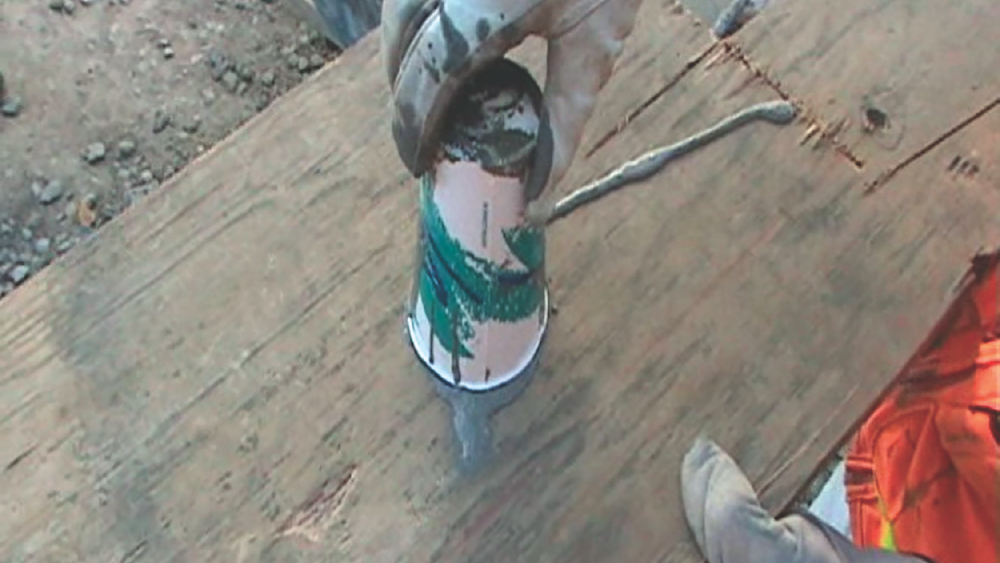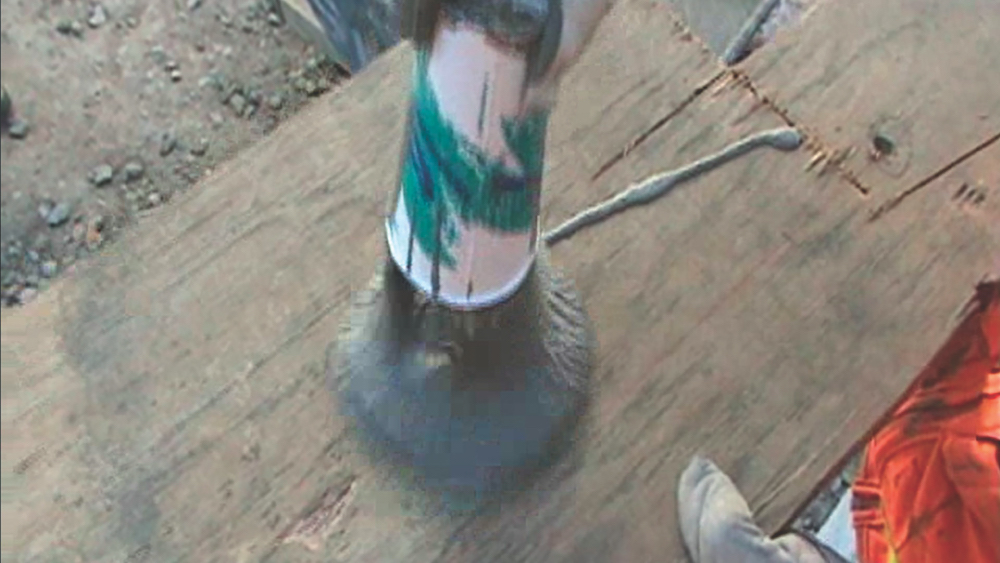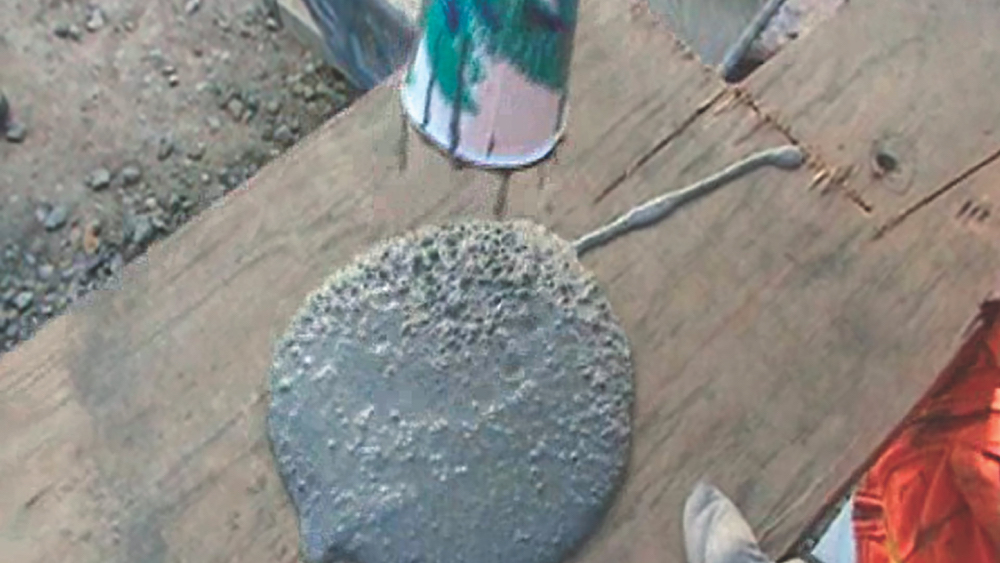Self-consolidating grout (SCG) and self-consolidating concrete are becoming more available and more widely used around the United States. However, for many masons, self-consolidating grout is still somewhat mysterious. Like any construction material, SCG has advantages and disadvantages, and a property that could be an advantage for one type of project can be a disadvantage for a different circumstance. This article will outline the pros and cons of SCG materials (from the perspective of someone who does not sell these materials), and some applications where SCG may be particularly beneficial.



PROS
- SCG is EXTREMELY flowable: The primary distinction between traditional masonry grout and SCG is that SCG contains admixtures that make it much more flowable that conventional grout. The consistency of SCG is sometimes compared to that of a smoothie or thin milkshake. It is difficult to illustrate the viscosity of a fluid using still photographs. However, the images below show the rapid spreading of SCG when a small cup of the material is overturned.
- No vibration needed: As the name of the material suggests, self-consolidating grout does not require mechanical vibration or puddling after placement.
- Easy installation: SCG is so flowable that it can travel 10 feet or more horizontally in both directions from a single pump location. Often entire walls can be grouted from a single pump location. Complete filling of lifts of 12’-8” high in under 1 minute have been documented and even higher lifts using a single pour of SCG have been reported. The labor required to place SCG is minimal.
- Voids are rare: Due to the very flowable nature of SCG, it is uncommon to encounter unfilled grout voids in SCG walls. Generally, SCG can flow through openings as small as about 3/8” wide, so mortar fins and other obstacles that might clog the flow of conventional grout do not generally stop the flow of SCG.
- Water resistance: In fully-grouted SCG construction, the space between the head joint mortar at the inner and outer face shells is generally filled with grout as part of the grouting process. Head joints tend to be the primary pathway for moisture through single-wythe masonry walls. Therefore, filling this joint solid with SCG can dramatically increase the moisture-resistance of the masonry.
- Lower water/cement ratio and less shrinkage: Since admixtures are used to dramatically decrease the grout viscosity, the amount of water required to achieve appropriate flow in SCG is actually less than conventional grout. This results in a lower water/cement ratio and less drying shrinkage of SCG than conventional grout.
- Included in Codes and Standards: SCG is specifically permitted to be used by the Structural Masonry Specification (TMS 602), which is referenced by the IBC Codes. The ASTM Standard for masonry grout (ASTM 476) also specifically includes self-consolidating grout. Therefore, SCG should meet the specification requirements for most projects.

 Figure 2. Screenshot from SpecMix video illustrating SCG flow using masonry wall with plexiglass windows. Full video at https://youtu.be/NTBmcPNdrnA.
Figure 2. Screenshot from SpecMix video illustrating SCG flow using masonry wall with plexiglass windows. Full video at https://youtu.be/NTBmcPNdrnA.CONS
- SCG is EXTREMELY flowable: The biggest advantage of SCG can also be one of its biggest challenges. SCG must be carefully contained or it can make a huge mess. For example, if a plumber has cored a hole in a masonry wall or an electrician has cut an opening and the resulting gaps have not been fully and carefully sealed, the SCG from an entire wall can drain out through these relatively small gaps. If SCG is to be used, more careful coordination with other trades may be required to avoid leaks. The walls to receive SCG should be almost water tight prior to grouting.
- Partially-grouted walls require additional effort: Since SCG can flow through even very small gaps, keeping grout out of places where it is not intended to be in partially-grouted construction can be more challenging with SCG than getting grout into places where it should be. For example, cross-webs in partially-grouted construction must be fully mortared on both sides of all grouted cells. If even one web is left ungrouted, all of the cells between that vertical reinforcing bar and the next one can be filled with grout through the resulting slot. Additionally, if the area to be grouted includes any bond beams that are not located at the top of the pour, grout stop mesh must be placed both below and above the bond beam course. Otherwise, all of the cells above the bond beam will be solidly grouted.
- Testing practices are different: Since SCG is much more flowable than conventional grout, different fluid property tests are required for SCG. For example, rather than measuring slump in the traditional manner, a property called “slump flow” is measured using an inverted slump cone to indicate the diameter of spread of the SCG. Another important test of wet SCG is the visual stability index, which helps ensure that the gravel is not segregating from the paste in a coarse SCG mix. These tests are described in ASTM C1611. However, compression testing in accordance with ASTM C1019 is very similar to traditional grout except that grout is placed into the masonry molds in a single lift and rodding is not required.
- Different aggregate (sand and gravel) requirements: The sand and gravel used in SCG often need to be different from conventional grouts in order to achieve proper flow. The proportion of fines (including both the cement and fine aggregates) must also be carefully controlled in order to achieve a stable mix.
- Cannot be proportioned in field: SCG can be very sensitive to small changes in the mix proportions and extremely small changes in the admixture proportions. Therefore, the proportioning of grout materials in the field is currently prohibited by standards. It is permissible to use preblended SCG materials that only require the addition of water in the field. However, in many markets SCG is only available using Ready-Mixed truck delivery.
- Retempering SCG: Since the addition of too much water to an SCG mix can cause the mix to become unstable (segregate), the addition of water to an SCG mix on site should be done very carefully and using appropriate field testing to ensure mix stability. Adding water on site to a Ready-Mixed SCG material requires extreme caution since excessive water can make the entire truckload unusable. Once an SCG material segregates, it often cannot be reconstituted to a stable mix. Therefore, manufacturer’s instructions should be followed carefully, and water should be added carefully and gradually. Addition of water in the field to SCG can also significantly impact the grout strength.
- Small batches may be more challenging: SCG is well-suited for grouting of large areas using large batches of material, but small batches of SCG can be cumbersome. If using Ready-Mixed materials, partial truckloads generally result in more expensive material costs. If using preblended materials, each and every batch of SCG must be carefully field tested to ensure mix stability. Achieving proper slump flow may require several attempts on each batch to ensure enough (but not too much!) water in each batch.

 Caption: Figure 3. Demonstration of the SCG slump flow test. From Figure 1 of NCMA Tek Note 9-2B.
Caption: Figure 3. Demonstration of the SCG slump flow test. From Figure 1 of NCMA Tek Note 9-2B.APPLICATIONS
Some applications are more suited to take advantage of the flowable nature of SCG than others. Examples of applications where SCG is well-suited include the following:
- Fully-grouted block walls
- Walls where reinforcing congestion or otherwise tight cells are a concern
- Filling voids in existing CMU walls (perhaps caused originally by mortar fins)
- Below-grade or other moisture-sensitive applications (if fully-grouted)
- “Converting” a partially-grouted wall to a fully-grouted wall
- Many repair and strengthening applications
Obviously, SCG can be successfully installed in many other types of applications, including partially-grouted walls. However, these installations generally require more care and experience, and masons may wish to begin using SCG in relatively simple applications.
If you would like to learn more about SCG, there is an excellent NCMA Tek Note (Tek 9-2B) available free online at the NCMA website.